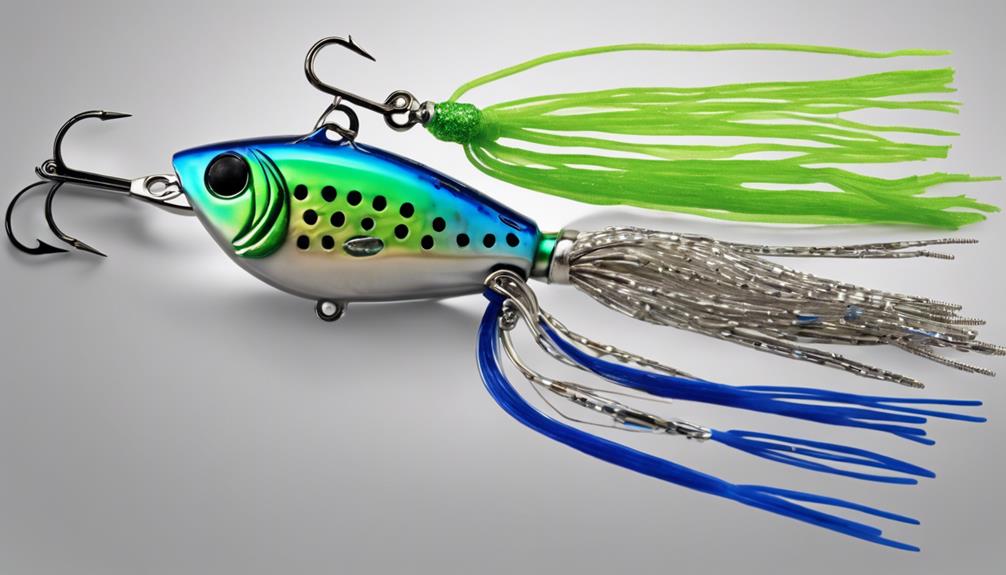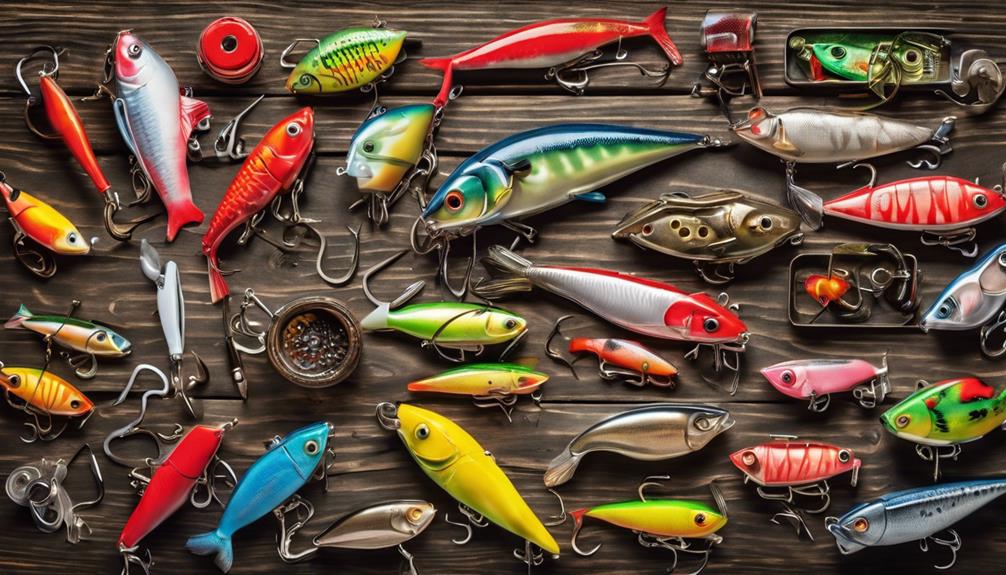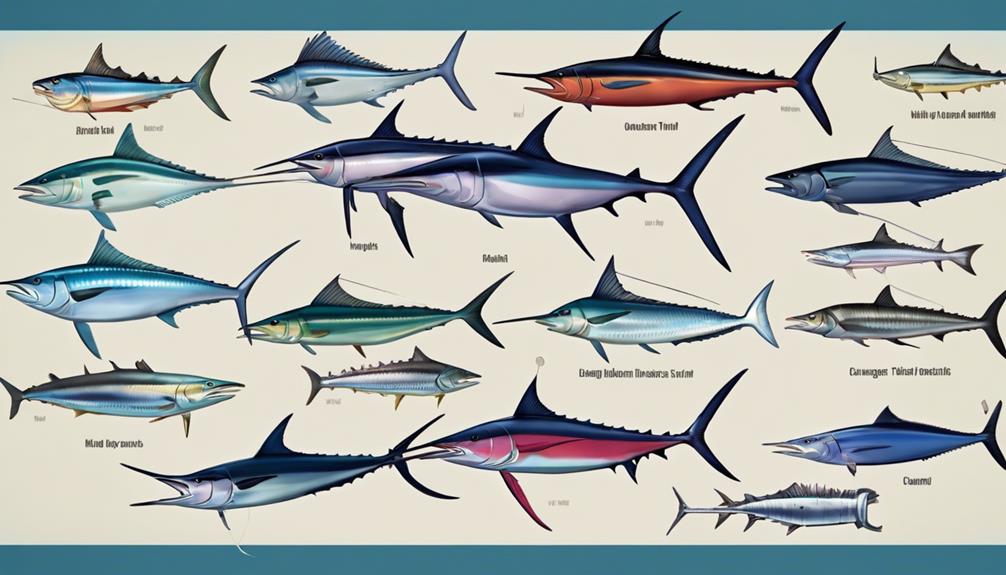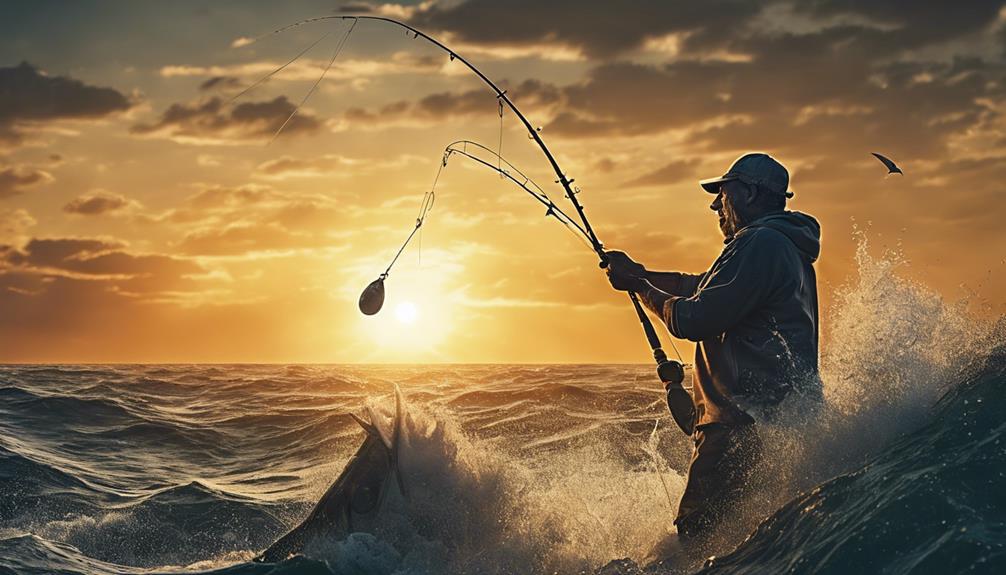Ever wondered which baits truly attract the biggest catches when deep sea fishing?
While many options are available, some have stood the test of time and proven to be highly effective.
These baits have a track record of enticing even the most elusive marine species, making them essential additions to any angler's arsenal.
From the depths of the ocean to your hook, these baits have a reputation for bringing in the prized catches you seek.
Squid
When deep-sea fishing, squid can be a highly effective bait to attract a variety of large fish species. Squid jigging techniques involve using specialized jigs to mimic the movements of squid in the water, enticing predatory fish to strike. To maximize your chances of success, consider squid baiting strategies such as cutting the squid into strips to release more scent into the water or using whole squid to attract larger game fish.
Understanding squid behavior in deep sea environments is crucial for successful fishing. Squid are known to be highly active creatures, often found in areas with strong currents or near underwater structures. When targeting squid as bait, consider fishing in areas known for high squid populations, such as underwater canyons or seamounts. These squid fishing hotspots can increase your chances of a successful deep-sea fishing excursion.
To effectively catch squid for bait, try using bright lights at night to attract them to the surface. Once the squid are near the surface, jig your bait in a motion that mimics the squid's natural movements. By mastering squid jigging techniques and understanding their behavior, you can significantly improve your deep-sea fishing results with this versatile and attractive bait option.
Mackerel
For deep sea fishing, mackerel serves as a reliable and versatile bait option due to its oily and flavorful nature. When using mackerel as live bait, it's essential to hook them properly to ensure they swim naturally in the water, attracting predatory fish effectively. Their oily flesh releases a strong scent that can lure various deep-sea species, making them a popular choice among anglers.
In addition to being used as live bait, mackerel is also an excellent option for artificial lures. Many fishing enthusiasts use mackerel-shaped lures to mimic the fish's appearance and movement in the water accurately. These artificial lures can be trolled at different depths to target specific species that are known to prey on mackerel.
Whether you choose to use mackerel as live bait or opt for artificial lures designed to imitate them, this fish can significantly increase your chances of a successful deep-sea fishing trip. Its natural oils and distinct flavor make it a top choice for attracting a wide range of game fish. So next time you head out for deep-sea fishing, consider adding mackerel to your bait collection for a productive and exciting angling experience.
Sardines
Curiously, what makes sardines a standout bait choice for deep sea fishing?
Sardines are a popular choice among anglers for deep-sea fishing due to their versatility and effectiveness in attracting a wide range of fish species. Here are some reasons why sardines are a top pick for your next fishing expedition:
- Versatility: Sardines can be used in various fishing techniques, making them a versatile option for different fishing conditions. Whether you're trolling, bottom fishing, or drift fishing, sardines can adapt to your preferred method.
- Effective Attraction: Sardines have a strong scent that can lure in predatory fish from a distance. Their oily texture and natural shine make them a tempting treat for game fish like tuna, mahi-mahi, and marlin.
- Conservation Considerations: When using sardines as bait, it's essential to practice responsible fishing habits to ensure the sustainability of sardine populations. Avoid overfishing and follow local regulations to help conserve this vital baitfish species.
When not used as bait, sardines can also be a delicious ingredient in various recipes. From sardine sandwiches to pasta dishes, sardines offer a flavorful addition to your culinary creations. Whether you're on the boat or in the kitchen, sardines prove to be a versatile and valuable resource for any fishing enthusiast.
Shrimp
Shrimp stands out as a versatile and effective bait choice for deep sea fishing due to its enticing scent and appeal to a wide range of fish species. When using shrimp as bait, consider different shrimp baiting techniques to maximize your catch. One common method is to hook the shrimp through the tail, allowing it to swim freely in the water, attracting predatory fish. Alternatively, you can thread the hook through the body of the shrimp to create a more secure attachment.
Apart from its effectiveness as bait, shrimp also offer a sustainable deep sea fishing option. With proper conservation efforts, such as using biodegradable bait bags and reducing bycatch, shrimp can be harvested responsibly to ensure the health of marine ecosystems. Choosing sustainably sourced shrimp for bait supports the balance of ocean life and helps maintain fish populations for future generations of anglers.
Next time you head out for deep sea fishing, consider using shrimp as your bait of choice. Not only does it attract a variety of fish species, but it also aligns with conservation efforts to protect the marine environment. By incorporating shrimp into your fishing arsenal and employing sustainable practices, you can enjoy a successful and eco-conscious fishing experience.
Octopus
Shrimp's success as a versatile bait option for deep sea fishing is well-known, and now let's explore the effectiveness of using octopus as bait in attracting a diverse range of fish species. Octopus, with its unique characteristics, can be an excellent choice when targeting various deep-sea predators.
- Octopus Behavior
- Octopuses are intelligent creatures known for their problem-solving skills and ability to adapt to different environments.
- They're expert camouflagers, capable of changing their color and texture to blend in with their surroundings, making them a stealthy bait option.
- Octopuses are also agile swimmers, which can attract fish looking for a quick and lively meal.
When considering octopus as bait, understanding their feeding habits is crucial:
- Octopus Feeding Habits
- Octopuses are carnivorous and feed on a variety of marine animals like crabs, clams, and small fish.
- They're opportunistic hunters, using their tentacles to capture prey with precision and speed.
- The scent and movement of an octopus can mimic live prey, enticing predatory fish to strike.
Herring
What makes herring a sought-after bait option for deep sea fishing enthusiasts? Herring is prized for its versatility and effectiveness in attracting a wide range of deep-sea species. When it comes to herring variations, anglers often prefer using fresh or frozen whole herring due to its natural oils and robust scent that can lure in big game fish like tuna, marlin, and swordfish. Another popular choice is strip herring, which involves cutting the herring into strips to create a fluttering motion in the water, mimicking the movements of injured baitfish.
In terms of herring rigging techniques, one commonly used method is the double hook rig. This setup involves running two hooks through the herring, allowing for a more secure attachment and better presentation in the water. Anglers also opt for bridle rigging, where a bridle is inserted through the herring's mouth and out its gill plate, ensuring the bait stays intact and swims naturally. Additionally, butterfly jigging with herring involves cutting the bait into butterfly wings to create a lifelike swimming action that entices predatory fish to strike.
Bonito

Highly valued for its vibrant colors and energetic movements, bonito stands out as a dynamic bait choice among deep sea fishing enthusiasts. When targeting bonito, it's essential to understand effective fishing techniques and preferred baits to maximize your chances of a successful catch.
Bonito Fishing Tips:
- Trolling Techniques: Bonito are commonly caught by trolling lures or baits behind a moving boat. Use brightly colored lures that mimic the bonito's natural prey to attract their attention.
- Chumming Strategy: Create a chum slick by dispersing small chunks of baitfish or fish oil to attract bonito to the surface. Once they're near your boat, cast your bait to entice a bite.
- Fast Retrieval Speed: Bonito are known for their speed, so when using artificial lures, reel them in quickly to mimic the rapid movements of fleeing baitfish and trigger a strike.
Bonito Bait Preferences:
When it comes to bait selection for bonito fishing, consider the following options:
- Live Bait: Bonito have a preference for live baitfish such as sardines, anchovies, or mackerel. Hook these live baits through the nose or tail to keep them lively in the water.
- Cut Bait: If live bait isn't available, fresh chunks of mackerel, squid, or mullet can also be effective in attracting bonito.
- Artificial Lures: Brightly colored feather jigs, spoons, or plugs that resemble the bonito's prey are popular choices for anglers targeting these fast-moving fish.
Anchovies
For deep sea fishing enthusiasts, anchovies serve as a versatile and effective bait option due to their small size and strong scent that attracts a variety of predatory fish species. When using anchovies as bait, there are some tips and tricks for success that can help maximize your catch. One key advantage of anchovies is their versatility in attracting different types of fish compared to other bait options. Their oily flesh releases a powerful scent that appeals to a wide range of predators, making them a go-to choice for many anglers.
To make the most of anchovies as bait, consider different anchovy baiting techniques for various species. For example, when targeting tuna, try butterfly filleting the anchovy to increase its visibility and movement in the water, enticing the tuna to strike. On the other hand, for bottom-dwelling species like snapper, rigging a whole anchovy on a dropper loop near the ocean floor can yield great results. Experimenting with different presentations and depths can help determine what works best for the specific fish you're after.
In comparison to other bait options, anchovies stand out for their effectiveness and convenience. Their natural oils and strong scent make them a reliable choice for attracting a wide variety of deep-sea predators, making them a valuable addition to any angler's tackle box.
Frequently Asked Questions
What Are the Best Locations to Find These Baitfish for Deep Sea Fishing?
When looking for baitfish for deep sea fishing, you'll want to consider their migration patterns and ideal depths.
Pay attention to tidal currents and weather patterns, as these can influence where the baitfish gather.
Are There Any Alternative Baits That Can Be Used for Deep Sea Fishing?
When looking for alternative baits for deep sea fishing, consider unconventional options. Trying new alternatives can lead to successful catches. These baits may offer benefits like attracting different types of fish or standing out from common choices.
Experimenting with diverse bait options can enhance your fishing experience and increase the chances of a fruitful trip. Be open to exploring unconventional baits to maximize your deep sea fishing results.
How Should These Baits Be Prepared and Rigged for the Best Results?
When preparing and rigging baits for deep sea fishing, focus on bait presentation and hook selection. Ensure bait storage to maintain freshness. Properly rig baits to entice fish effectively.
Use sharp hooks that match the size of the bait. Avoid overhandling baits to keep them fresh and appealing to fish. Experiment with different rigging techniques to find what works best in different fishing conditions.
Are There Any Specific Techniques for Using These Baits to Attract Different Types of Deep Sea Fish?
When fishing in the deep sea, bait presentation is crucial for attracting different types of fish. Understanding fish behavior can help you select the right lure and improve your fishing techniques.
By varying your bait presentation, such as using different speeds or depths, you can entice a wider range of deep-sea species.
Experiment with techniques like jigging or trolling to see what works best for the specific fish you're targeting.
What Is the Best Time of Day or Season to Use These Baits for Deep Sea Fishing?
When targeting deep-sea fish, consider tidal patterns and fish behavior to determine the best time for fishing. Understand how weather conditions and moon phases impact fish activity.
Timing your fishing trips during high tide when fish are more active can increase your chances of success. Additionally, certain species might be more abundant during specific seasons, so adjusting your fishing schedule accordingly can lead to better results.
Conclusion
So next time you head out for deep sea fishing, make sure you have these proven baits in your tackle box.
Squid, mackerel, sardines, shrimp, octopus, herring, bonito, and anchovies are all excellent choices for enticing those big catches.
With the right bait, you'll be sure to have a successful and exciting fishing adventure out on the open sea.
Happy fishing!



